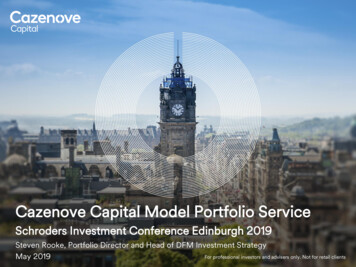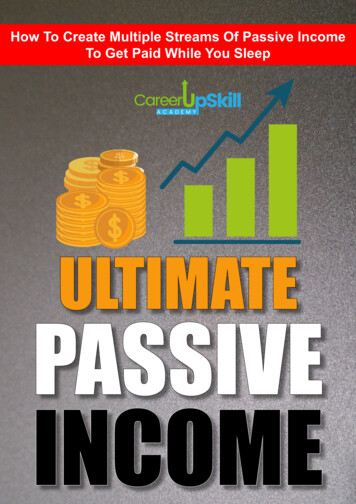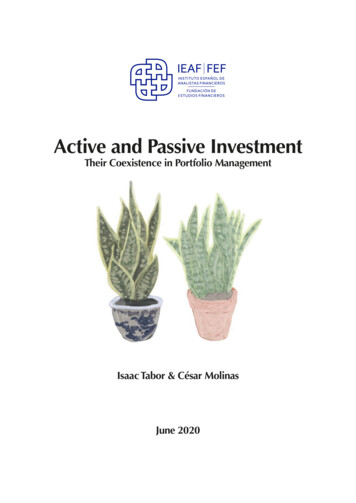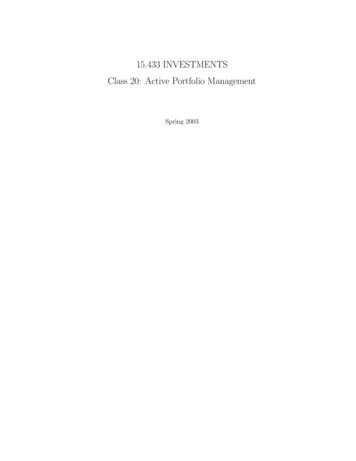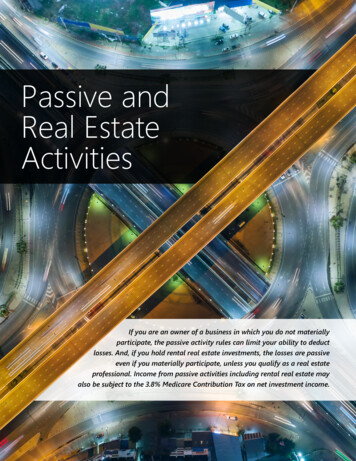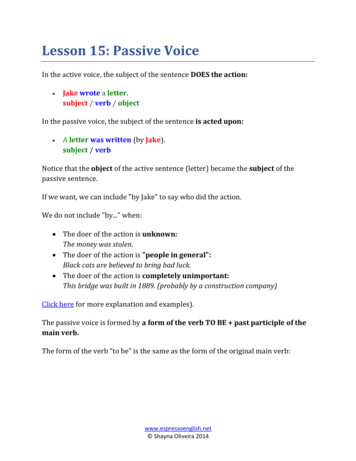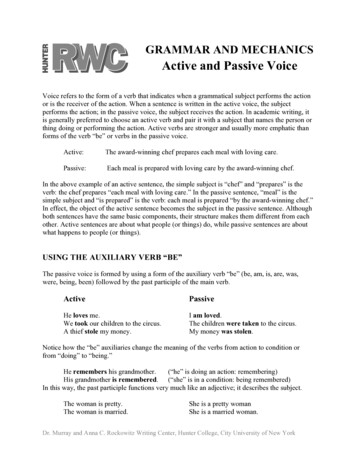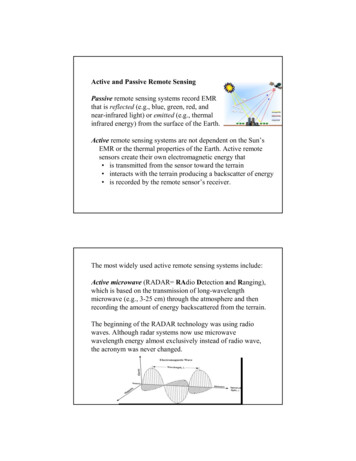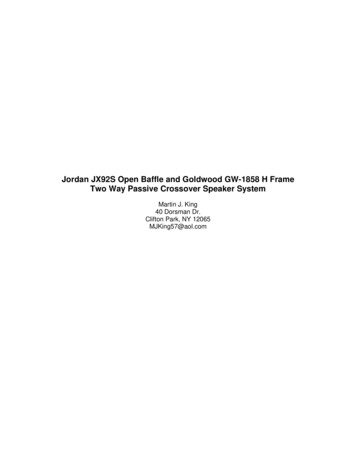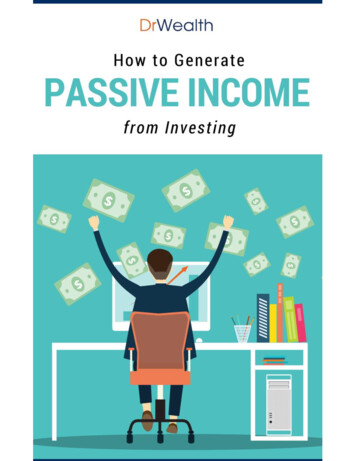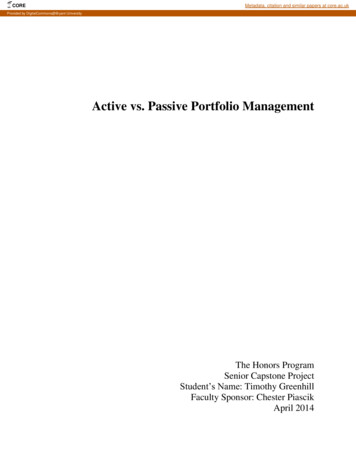
Transcription
COREMetadata, citation and similar papers at core.ac.ukProvided by DigitalCommons@Bryant UniversityActive vs. Passive Portfolio ManagementThe Honors ProgramSenior Capstone ProjectStudent’s Name: Timothy GreenhillFaculty Sponsor: Chester PiascikApril 2014
Active vs. Passive Portfolio ManagementSenior Capstone Project for Timothy GreenhillTable of ContentsABSTRACT . 3INTRODUCTION . 4LITERATURE REVIEW . 5The Efficient Market Hypothesis . 5How costs kill investment returns . 5The Effects of Style Drift . 8Tax Considerations. 9The Building Blocks of Active Management. 10Building the Case for Active Management . 12Success of Active Managers . 13The Advantage of Passive Management . 14Initial Analysis Conclusion . 16METHODOLOGY . 16Data Collection . 16Data Analysis . 17RESULTS . 17One Year Returns . 17Three Year Returns . 18Five Year Returns . 18Effects of Market Capitalization . 19Gross and Net Costs . 20CONCLUSION . 21CONCERNS . 22POTENTIAL NEXT STEPS . 23APPENDICES . 24Appendix A – Passive Fund Data . 24Appendix B – Active Fund Data . 25Appendix C – Scatter Plot for Gross Costs . 26Appendix D – Scatter Plot for Net Costs . 26Appendix E – Cost Comparison. 27Appendix F – Turnover Ratio . 27Appendix G – 1 Year Return Output . 28Appendix H – 3 Year Return Output . 28Appendix I – 5 Year Return Output . 29Appendix J – Market Capitalization . 29Appendix K – Gross Costs on 5 Year Returns. 30Appendix L – Net Costs on 5 Year Returns. 30REFERENCES. 31-2-
ABSTRACTIn the finance community there is a huge debate about whether or not active portfolio managerscan provide better returns than passive managers. While active managers often provide excessreturns, the costs of running an active fund offset whatever gains were made in the market.The objective of this report is to figure out whether or not active funds provide larger returnsthan passive funds on a cost adjusted basis. This report will identify which type of fund is amore cost effective investment, as well as identify different properties of funds and how theyoperate. The goal of doing this research is to provide information to the average investor,rather than a multi-millionaire, about what kind of fund may be more appropriate for them toinvest in. To successfully complete this project I collected quantitative fund data from fidelity,and qualitative information from various finance and business journals. After running amultivariate analysis of variance on my data I found that passive funds in the 1 year periodprovided significantly greater returns than active funds on a cost adjusted basis. Next, over the3 year period, there was no significant difference between the returns of active and passivestock funds. However, during the 5 year period return active funds proved to be a more costeffective investment strategy. From my results I have concluded that active portfoliomanagement is not a more cost effective investment tool than passive management.
Active vs. Passive Portfolio ManagementSenior Capstone Project for Timothy GreenhillINTRODUCTIONIn the financial markets the case for active portfolio management is often a difficult one to make.While many individuals opt to put their money in index funds, others trust their money withactive managers who are on a search for positive alphas and undervalued securities. Thequestion is whether or not there is any value in putting your money into an actively managedequity fund. Although active managers swear they can create better returns, it is often the costsof investing that make their funds not as attractive or profitable. Management fees and highturnover ratios often cause these active managers to miss their benchmarks. Passive (Index)funds on the other hand are much less expensive because they try to imitate an index and tradewith much less frequency (Seawright 2012).In order for active managers to outlast passive funds they must be able to produce large enoughreturns that will offset the fees incurred from trading and managing the fund (Ambachtsheer1979). The job of an active portfolio manager is to select securities, find positive alphas, andcreate return (Waring 2003). It sounds simple enough, but creating value in a very efficientmarket is difficult. Passive funds nowadays are very attractive due to their reduction in cost,increased tax efficiency, and ability to avoid spending an increasing amount of time researchingcompanies (Carosa 2005). While many fund managers believe they have the ability tooutperform the market, Jarrow claims that “the existence and persistence of positive alphas ismore a fantasy than a fact (Guofu 2008).”The rest of this research project is done as follows. In the next section there is a literature reviewwhich exemplifies ample research about active and passive management. Next I will cover themethodology for my research. This will be followed by my personal research results, as well asthe implications of my research. I will then conclude my research with suggestions on ways itcan be furthered and strengthened in the future.-4-
Active vs. Passive Portfolio ManagementSenior Capstone Project for Timothy GreenhillLITERATURE REVIEWThe Efficient Market HypothesisAs specified in the previous paragraph, it is very difficult for actively managed funds to produceexcess returns in a very efficient market. The efficient market hypothesis states that it is notpossible to beat the stock market because all relevant information is taken into account with thepricing of the security (Investopedia). The hypothesis is saying that stocks always trade atmarket value, and that higher returns only come with greater risks.Another way of looking at this is by thinking about a large dart board with names of stocks on it.Now close your eyes and throw a dart at the dart board. The stock you “chose” has just as goodof a chance as making a profit as any one of those other companies on the board. No matter howmuch research you do you will not be able to choose a company that will provide a better returnwith the information you find.Regardless of this theory, there are still managers who beat the stock market on a regular basis.Many individuals also claim that there are plenty of inefficiencies in the market that can beexploited to make a return. Overall, well run actively managed funds have performed abovetheir benchmark and the market in the long term because they have 5-star managers (Loth). EvenWarren Buffett, the most well-known investor of our time stated “I’d be a bum on the street witha tin cup if markets were efficient.” (Warren Buffett)How costs kill investment returnsRavi Shukla also has a convincing analysis on how active portfolio managers fall short ofobtaining excess returns. In his report his goal was to compare the returns of funds with andwithout interim revisions to the portfolio (Shukla 2004). He identifies how portfolio managersclaim to have superior skills to invest money and can create a more positive return by“monitoring and revising their portfolios continuously in response to the market conditions.”(Shukla 2004) Shukla’s sample is made up of 458 different mutual funds with 1117 snapshotstaken of the funds over a 7 year period. Below is the chart (Figure 5) of when the snapshotswere taken (date form yyyymm).-5-
Active vs. Passive Portfolio ManagementSenior Capstone Project for Timothy GreenhillFigure 5 – Snapshots of FundsShukla also collects much more quantitative information about each fund. Figure 6 below showssome simple statistics about different aspects of the funds he was sampling. TMV stands formarket value, NSec is the number of securities in the fund, SumWt is the % of the portfolioinvested in stocks, Top10Wt is the % of investment in the 10 largest holdings of the fund, Exp isexpense ratio, and Turnover is the turnover ratio of the fund.Figure 6 – Fund StatisticsAs you can see the sampled funds have a wide range of fees, weightings, and turnover ratios.Two important pieces of this chart I would like to point out are the expense ratios and turnoverratios. An expense ratio of 7.34% is extremely high for a fund. It means management takes over7% from your investment for managing your money, every year. Also, a turnover ratio of3243% means that the fund is constantly trading. For example, pretend you have 10 stocks inyour current portfolio. Since you are an active manager you want to trade your stocks for better-6-
Active vs. Passive Portfolio ManagementSenior Capstone Project for Timothy Greenhillopportunities. If you trade all ten of your stocks for new ones this means your current turnoverratio is 100%. If you trade them all again it becomes 200%. A turnover ratio of 3243% meansyou have turned your portfolio over more than 32 times. The repercussion of this is significantlymore transaction costs, especially when you have a large amount of stocks in your fund.The results of Shukla’s tests are similar to that of many individuals who support the passivelymanaged funds.Figure 7 – Excess Fund ReturnsAs you can see there from figure 7, there is a normal distribution of excess returns on stockfunds. Overall the data shows 49.76% of funds having positive excess returns. Whenperforming a t-test on the average excess returns, Shukla failed to reject the null hypothesis thatthere is an average excess return of 0. Although the results of the test suggest that excess returnsare possible, Shukla states that “all of it is wiped out by the incremental trading costs and on anaverage, would not be different if the managers had left their portfolios alone.” (Shukla 2005) Inaddition to this it was found that there is a direct relationship between returns and expense ratios,but not between returns and turnover ratio. This means that a more expensive manager is morelikely to create a higher return (before costs). On the other hand, funds with smaller turnoverratios were found more likely to do better. Having a lower turnover ratio is an aspect of passive,not actively managed funds. Overall the results suggest that active management does notprovide the best possible return for the shareholders of the funds (Shukla 2005).-7-
Active vs. Passive Portfolio ManagementSenior Capstone Project for Timothy GreenhillThe Effects of Style DriftStyle drift is “The divergence of a mutual fund from its stated investment style or objective.”(Investopedia) In the investment world, managers normally stick to one investment strategyrelating to the types of stocks they invest in. There are 9 “style boxes” that can show a fundsgeneral investment objective. Below is the basic style box that shows the different strategies.Figure 9 – Style BoxIn figure 9 the Small, Medium, and Large pertain to the size of the market capitalization of thecompanies. Generally speaking, a small cap fund is one with a market capitalization under 2billion, mid-cap is between 2 and 10 billion dollars, and large cap is over 10 billion. The otherthree labels pertain to Value, Blend, and Growth companies. Value investing focuses on buyingstocks worth 1 for 50 cents because it is believed that they are undervalued. This is otherwiseknown as trading at a discount (Strong 2009). Growth investors are the opposite. The focus ofgrowth investors is to favor stocks that have been advancing in the market due to momentum(Strong 2009). Therefor they are willing to pay more money for a stock that may be overvaluedbecause they think the price is going to continue to rise. A blend strategy focuses on the purchaseof both growth and value securities.Being an active manager gives you the flexibility to choose the style of your investment strategy.You can also change the style of your investment based on what you feel will give you the betterreturn. As an investor you may be nervous about a change in investment style. You may ask the-8-
Active vs. Passive Portfolio ManagementSenior Capstone Project for Timothy Greenhillquestion: Does the manager of my mutual fund have the ability to trade effectively outside of hisfield of expertise? Faff and Holmes believe style drift is a positive for actively managed funds.In their studies they found with significance (r 0.170, p 0.016) that “ superior selectivity (ofstocks) is related to greater levels of style drift.” (Holmes 2007) This means that fund managerswho choose stocks out of their style can improve their returns. It also proves that style drift canbe positive for active managers because it is positively related to stock selectivity. These resultsshow a direct case of how giving a manager more freedom (which is an attribute of activemanagement) can lead to increased returns.Tax ConsiderationsOne topic that cannot be forgotten is the taxation of capital gains in the stock market. As youhave heard before, “nothing is certain but death and taxes.” (Fpanet 2007) Mutual funds gettaxed when their capital gains are greater than their capital losses (meaning they made a profit inthe market). For long-term holdings (greater than one year) there is a 15% tax for all individualsin the 25% tax bracket, and a 5% tax for individuals in the 10-15% tax bracket. Short term taxrates are even higher (Morningstar).In order to avoid getting taxed at a high rate you should look for funds that are more “taxfriendly.” One example of how a fund can be more tax friendly is with tax-loss carry-forwards.This is when a fund has unrealized losses from previous years that can be used to offset gainsand reduce taxation in future (Fpanet 2007, Morningstar). Also, if funds can actively match theirgains and losses properly they will have the ability cut costs by being tax efficient (Fpanet 2007).Another way to avoid taxation is to invest in funds that do less buying and selling (less than 10%turnover is considered tax-efficient), which means less realization of capital gains and losses(Morningstar). Unfortunately, for actively management funds turnover is normally much higherthan passive funds, which means more taxes from realized gains.Overall, the ability of a fund manager to consider taxes in his investment strategy can have amajor impact on a fund. Because active managers are more prone to high taxes due to highertrading volume and turnover, it is important that they focus on having some tax-efficiency.-9-
Active vs. Passive Portfolio ManagementSenior Capstone Project for Timothy GreenhillFigure 10 – The Effects of TaxationAbove (in figure 10) is a study by morningstar that shows some of the most tax inefficient fundsin the market and how much of an impact they can have on returns (Cendrowski 2012). As youcan see, even managers who are able to make returns over 10% can end up with under 1% gainafter taxes. The cases above are of course extreme, but they show the importance of taxconsideration in all kinds of mutual funds.Feng, Kraft, and Weiss conducted a study to see whether or not fund managers do an effectivejob at planning for the costs incurred from the capital gains taxes. The conclusion of their reportis that both open-end and close-end funds change their investment strategies based on thechanges of the tax rates in years to come (Feng 2011). For example, in years where taxes areexpected to decrease in the following year, managers realize less returns in order to increase taxefficiency. For the opposite, in years where taxes are expected to increase the following year,managers realize more returns in the present year to avoid higher taxes in the future (Feng 2011).While this shows taxes are taken into consideration by portfolio managers, it is still important forthe investor to research funds and ensure they are tax efficient before investing. This applies toboth active and passive funds.The Building Blocks of Active ManagementAmbachtsheer and Farrell talk about five basic building blocks all actively managed funds musthave in order to be successful (Ambachtsheer 1979).1) Ability to judge securities that are over or under valued- 10 -
Active vs. Passive Portfolio ManagementSenior Capstone Project for Timothy Greenhill2) Assessment of correlation between their judgments and equity returns3) Conversion of judgments into unbiased predicted returns4) A well put together investment objective5) The ability to carry out transactions of securities.Valuation of securities to define whether they are over or under valued is the pinnacle of activeinvestment strategies. The goal of valuation is to find a “cheap” stock that should be trading at ahigher price (buy low and sell high). There are many different fundamental approaches analystscan use to evaluate a security. The Solomon Brothers (a company that no longer exists) forexample used ROE, dividend yield, quality ranking, and regulatory environment ranking in theirevaluation (Sorensen 2009). Other evaluation methods include the free cash flow model, priceratio models, and EV/EBITDA.Based on the valuations companies make such as the ones above, managers assess how theirwork compares to the return of the actual companies. An individual or fund that has an accurateassessment of the growth of stocks can be very successful in choosing “winners” in the market.The fund managers must now predict returns of companies without using bias. Behavioralproblems and biases are both very important topics when talking about investing. While there isan advantage to doing in depth analysis and being able to innovate, as humans we have a limitedcapacity for analyzing securities, and often show behavioral biases which must be eliminatedfrom our studies (Sorensen 2009). Falling in love with a stock is not an appropriate way toinvest. Doing so could lead to a severe loss of funds. Managers and analysts must makereasonable and realistic predictions to be successful.It is also very important for investment firms to have a goal/objective and stick to their plan.Funds set benchmarks to beat a certain indexes. In doing so they also set restraints on theirturnover ratios, fees, and types of companies to invest in. Without an objective, funds will beinconsistent, lose focus, and decrease their chances of beating their benchmark.The final building block for an actively managed fund is having the ability to carry out atransaction. For management this simply means buying and selling securities based on your- 11 -
Active vs. Passive Portfolio ManagementSenior Capstone Project for Timothy Greenhillevaluations. After this step is complete the fund will hopefully have success with theirinvestment choices.Building the Case for Active ManagementBruce Jacobs and Kenneth Levy believe that having an active portfolio is more effective due tothe ability to have active security weights, as well as the ability to sell short, instead of simplytaking the long position. Their goal was to identify different opportunities for return frominvesting in different ways (Jacobs 2006). In their report, Jacobs and Levy compare enhancedactive equity approaches with combinations of long and short, as well as active and passiveapproaches to investing. They also evaluate the exposure to the stock market, as well as the riskassociated with different strategies.Figure 1- Portfolios from least risky to most risky (left to right)In the indexed equity portfolio, no security is under- or over-weighted. On the other hand, theactive equity portfolio has 65% of its capital dedicated to more attractive opportunities. In theenhanced portfolio there are more aggressive weights. For example, 20% of the investment is inshorted opportunities. The enhanced portfolio also takes advantage of 20% leverage on bothshort and long opportunities, putting the risk at 140 (potential downside) for every 100invested. Jacobs and Levy also talk to the importance of trading costs, which is alwaysaccounted for in active investment strategies. In their example, the enhanced active equity reportis the most expensive to manage, while the index equity fund is the least expensive. Althoughpassive funds are the least expensive, being able to short stocks and weight them actively givesyou a higher return on your investment.- 12 -
Active vs. Passive Portfolio ManagementSenior Capstone Project for Timothy GreenhillThe conclusion that was drawn from their research was that “the progressive relaxation ofportfolio constraints as one moves from indexed equity to enhance indexed to active equity toenhanced active equity can be expected to produce progressive improvement in portfolioperformance.”(Jacobs 2006) While this is true, the test was done in the most optimalenvironment. It assumes that active managers have done their evaluations accurately and that themarket reflects their predictions. Still, their research sets a basic groundwork that shows howactively managed funds have more opportunity than passive funds to make larger returns despitemore transaction costs and management fees.Success of Active ManagersVanguard claims their actively managed funds can outperform passively managed funds on aregular basis. Over a 15-year period their funds have produced excess returns of .5% above theirbenchmarks (Steinert-Threlkeld 2013). This means that overall they are outperforming themarket. The key in the active management world is to find the right managers who implement astrategy that will give them above average returns. At Vanguard, 40% of their active fundsoutperform passively managed funds (Steinert-Threlkeld 2013).Although not any random fund or manager is going to give you the best returns, choosing theproper one can give you great returns in the bull markets, and preserve your capital in times ofeconomic distress (Carosa 2005). To state it simply, there are periods of time where the activemanaged funds can succeed. In an experiment done by Carosa, he is able to identify that “U.S.equity funds have historically beat the S&P 500 roughly two-thirds of the time.” (Carosa 2005)Figure 8 below shows the percent of funds outperforming the S&P. As you can see, equity fundsare outperforming the market, and the actively managed funds with the higher fees areoutperforming even more (these fees are very low compared to the average active fund). Thisdata was taken for every possible 12 month holding period between the years 1975 and 2004.- 13 -
Active vs. Passive Portfolio ManagementSenior Capstone Project for Timothy GreenhillFigure 8 – Funds Outperforming the S&P 500The Advantage of Passive ManagementThe main challenge an active manager faces is their costs (Blake 2009). Active managementfees have been going up steadily for some time. With the costs going up, the difficulty for activemanagers to beat their benchmark is even greater (Ennis 2005).Figure 2 – Expense Ratios Increasing Over TimeRichard Ennis has provided an extensive study on how the success of active managers hasdecreased due to their fees. The point of his study was to understand what it means for activemanagement fees to be too high. In order to do this, Ennis did an analysis of the probability ofsuccess of managers at different management fee levels.- 14 -
Active vs. Passive Portfolio ManagementSenior Capstone Project for Timothy GreenhillFigure 3 – Success RatesFigure 4 – Success Rates 2The first column on the left (of figure 3) shows the amount of fees that were charged to theaccount. The second column represents the amount of management skill required for investorsto have a 50% chance of making returning a positive alpha. As you can see, at the 3% fee levelyou would need a manager with nearly perfect predictive analysis skill to have at least a 50%chance of obtaining positive alpha. In the third column Ennis shows the probability of earning apositive alpha when the manager skill level is 80%. As expected, the chance of making apositive return as fees increase is much lower than a fund with low fee levels. Figure 4 showsyou another representation of how management fees greatly decrease the probability of creatinga positive return. The Y axis represents the probability of success, while the X axis representsthe skill level of managers.- 15 -
Active vs. Passive Portfolio ManagementSenior Capstone Project for Timothy GreenhillThe conclusion of this experiment is that active management fees are too high despite the abilityof managers to create positive alphas. As fees increase the chance of investor success is drivenway down (Ennis 2005). Ennis also predicts that as markets become more efficient and costsbecome higher, there will be a move towards plausible pricing which gives investors a betterchance for a real return (Ennis 2005). If this prediction is correct it would make it even harderfor active managers to create excess return because securities would already represent their fairmarket value.Initial Analysis ConclusionAfter collecting and analyzing secondary research I have come to the initial conclusion thatpassively managed funds are more effective at producing returns than actively managed funds ona cost adjusted basis. Although actively managed funds seem to have more opportunity to beattheir benchmarks than passive funds, they are unable to capitalize. Much of this due to the highfees they charge for their constant attention to the fund. In addition to this, although mostmanagers are very tax efficient, passive managers are even more efficient due to their incrediblylow turnover ratios. With this said, there is still opportunity to make great returns from an activefund even after costs. There are funds out there that can beat their benchmarks, they are justdifficult to find. This is why it is can be more advantageous for the average investor to invest ina passively managed fund.METHODOLOGYData CollectionTo collect data about active and passive funds I used Fidelity’s investment website. The siteprovided me with all the information I needed about hundreds of different funds offered to thepublic. My collected data included 36 active, and 36 passive funds. I collected informationabout returns over 1, 3, and 5 year periods. Along with this I collected information about namesof the funds, what style box they fit into, expenses (gross and net), and turnover ratios. Thedifference between net and gross expenses is reimbursement for fee waivers. Some funds havewaivers for their fees that allow them to receive reimbursements and reduce their net expenses.In order to choose the funds I sorted
Active vs. Passive Portfolio Management Senior Capstone Project for Timothy Greenhill - 7 - opportunities. If you trade all ten of your stocks for new ones this means your current turnover ratio is 100%. If you trade them all again it becomes 200%. A turnover ratio of 3243% means you have turned your portfolio over more than 32 times. The .
